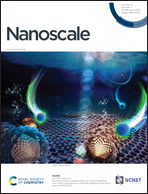Active site manipulation in MoS2 cluster electrocatalysts by transition metal doping†
Abstract
The development of non-platinum group metal catalysts for the hydrogen evolution reaction (HER) in water electrolyser devices is essential for their widespread and sustainable deployment. In recent years, molybdenum disulfide (MoS2) catalysts have received significant attention as they not only exhibit good electrocatalytic HER activity but also, crucially, acid-stability. However, further performance enhancement is required for these materials to be competitive with Pt and to that end transition metal doping of MoS2 has been explored as a route to further increasing its catalytic activity. In this work, cluster beam deposition was employed to produce controlled cobalt-doped MoS2 clusters (MoS2–Co). We demonstrate that, in contrast to previous observations of performance enhancement in MoS2 resulting from nickel doping (MoS2–Ni), the introduction of Co has a detrimental effect on HER activity. The contrasting behaviours of Ni and Co doping are rationalized by density functional theory (DFT) calculations, which suggest that HER-active surface vacancies are deactivated by combination with Co dopant atoms, whilst their activity is retained, or even partially enhanced, by combination with Ni dopant atoms. Furthermore, the adatom dopant–vacancy combination kinetics appear to be more than three orders of magnitude faster in MoS2–Co than for MoS2–Ni. These findings highlight a fundamental difference in the influence of transition metal dopants on the HER performance of MoS2 electrocatalysts and stress the importance of considering surface atomic defects when predicting their behaviour.



 Please wait while we load your content...
Please wait while we load your content...